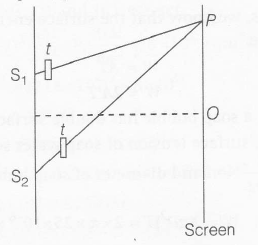Answer:
Option C
Explanation:
Given, refractive index of first sheet μ1=1.6 refractive index of second sheet μ2=1.3 and wavelength of light λ=600nm=600×10−9 m
A young's double-slit experiment is shown below, in which two thin sheets have covered the slits . So, the path difference introduced in slit 1.
△x1=(μ1−1)t=(1.6−1)t=0.6t

Similarly , path difference introduced in slit 2,
△x2=(μ2−1)t=(1.3−1)t=0.3t
So, the net path difference introduced in central maxima,
△xcentralmaxima=△x1−△x2=0.6t-0.3t=0.3t
For central maxima, which occupied the 10th bright fringe,
△xcen=10λ
⇒ t= 10×600×10−90.3−20μm
Hence, the correct option is (c)